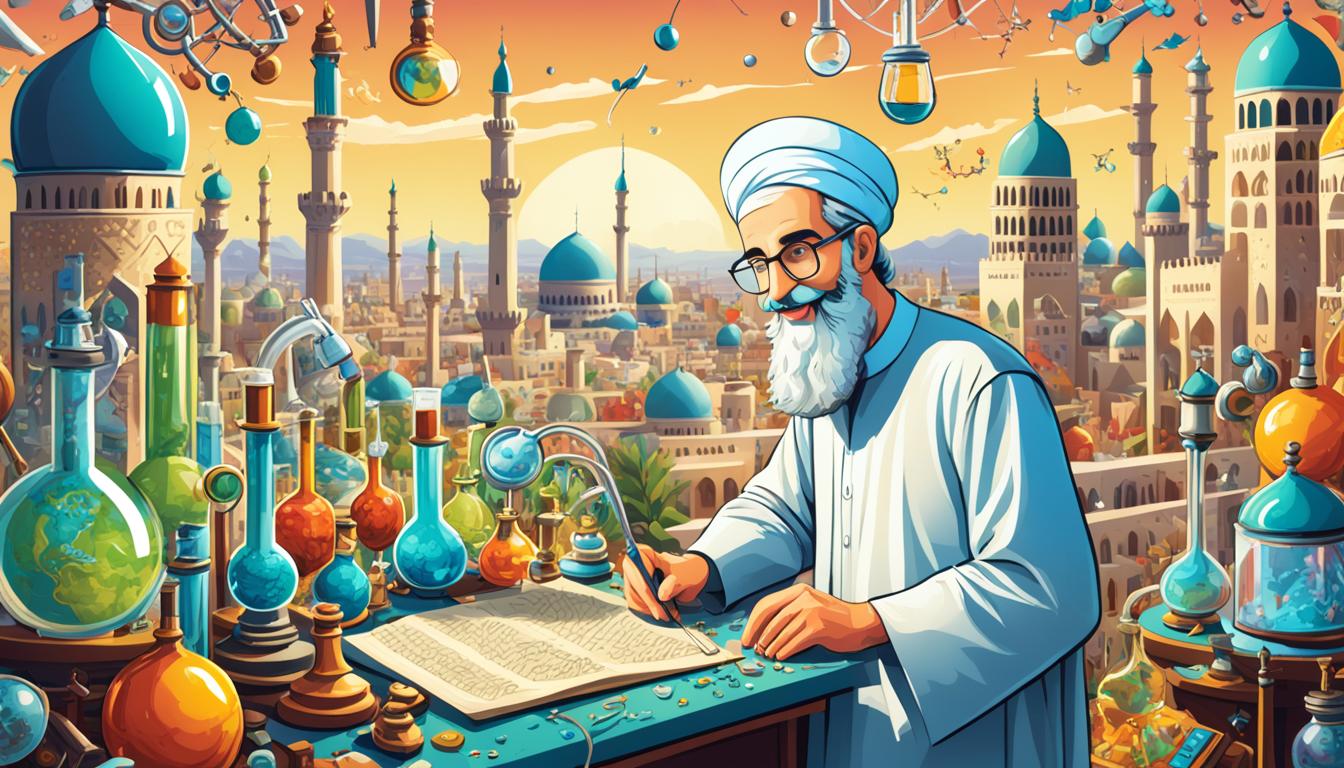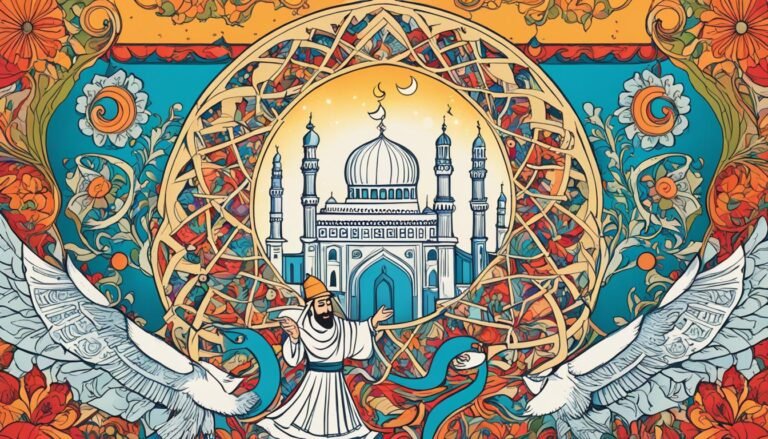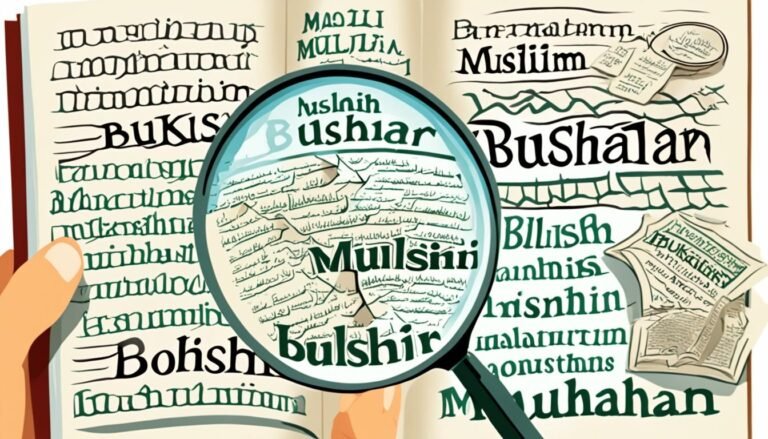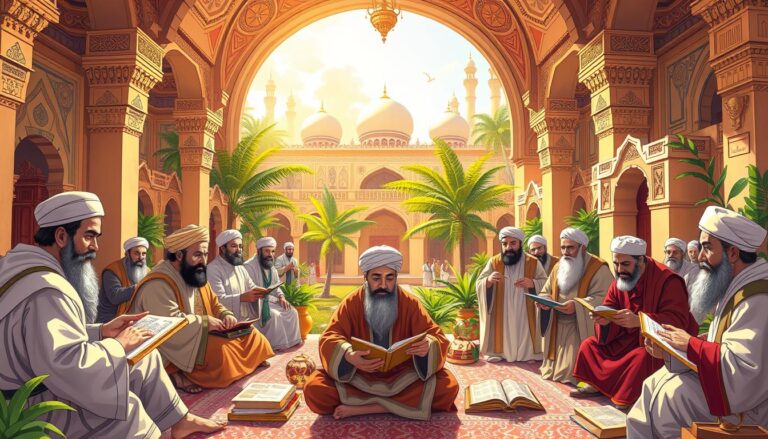The Intersection of Islam and Science: A Historical Perspective
How did a civilization that once sparked the flames of scientific discovery find itself in a complex dance with faith and skepticism? The interplay between Islamic history and scientific inquiry is full of contradictions. Yet, it is rich with achievements that changed fields like mathematics, astronomy, and medicine. Scholars from the Islamic Golden Age greatly helped us understand the world. They laid the groundwork for modern science and challenged many beliefs about Islam and science.
This article looks into the fascinating evolution of scientific contributions in Islam. It highlights key figures and groundbreaking discoveries that show a legacy often missed in today’s talks. Join us as we explore how, at various points in history, faith and reason coexisted. Sometimes they were in harmony, and sometimes in tension.
Key Takeaways
- The Islamic Golden Age was key in advancing mathematics, astronomy, and medicine.
- Islamic scholars made big contributions that shaped modern scientific thought.
- The relationship between religion and science has changed and varies across cultures.
- Scientists like Al-Khwarizmi and Ibn al-Haytham changed scientific inquiry.
- Understanding Islamic history gives us valuable insights into today’s talks on science and faith.
- The view of conflict between science and religion differs a lot around the world.
Understanding the Historical Context of Islamic Science
The history of Islamic science is a story of blending different cultures. This started in the 8th century with the Islamic Empire. It brought together knowledge from ancient places like Greece, Persia, and India.
This mix of cultures led to a time of great learning. It helped Islamic science grow and evolve.
The Quran is key to understanding this blend of science and faith. It talks about big ideas like the Big Bang and how life begins. It shows a deep understanding of human development and life’s complexity.
Quranic verses also talk about mountains and their role in keeping the Earth stable. They highlight the importance of water for life. This shows a deep knowledge of the natural world.
This mix of science and faith created a culture of learning in Islamic societies. Centers of learning sprang up, leading to new discoveries in fields like math and medicine. This added to the world’s knowledge.
Islamic science’s growth also influenced European thought during the Renaissance. This led to new ways of seeing science that still affect us today.
| Aspect | Details |
|---|---|
| Influential Texts | Quranic verses aligning with science |
| Pivotal Themes | Creation of the universe, human development, earth’s stability, significance of water |
| Timeframe | 8th century onwards |
| Impact on Society | Fostering scientific inquiry integrated with theology |
The Significance of the Islamic Golden Age
The Islamic Golden Age lasted from the 8th to the 16th centuries. It was a time of great intellectual growth that changed many scientific fields. Scholars from different cultures came together, leading to big leaps in math, astronomy, and medicine.
Scholars like Al-Razi and Ibn Sina made huge impacts. They changed medicine and chemistry with their new ideas. For example, Ibn Sina’s *Canon of Medicine* was a key book in both Eastern and Western medicine for a long time.
Places like the House of Wisdom in Baghdad were key to learning during this time. They translated knowledge from Greco-Roman and Indian cultures into Arabic. This helped spread knowledge that would later influence Europe.
The Islamic Golden Age also brought practical changes. It improved farming and listed many plant species. Scholars like Ibn al-‘Awwam al-Ishbīlī made big changes in agriculture.
This period of time left a lasting mark on science. The work of Islamic scholars changed how we see the world. Their discoveries and ideas are still important today.
| Field | Key Contributions | Notable Scholars |
|---|---|---|
| Medicine | Development of medical ethics; diagnosis and treatment of diseases | Al-Razi, Ibn Sina |
| Mathematics | Advancements in algebra, trigonometry, and the use of Arabic numerals | Al-Khwarizmi |
| Astronomy | Improvement of astrolabes; accurate determination of Qibla | Al-Battani, Al-Farghani |
| Agriculture | Introduction of new crops; systematic plant documentation | Ibn al-‘Awwam al-Ishbīlī |
Scientific Contributions in Islam: Key Discoveries
The Golden Age of Islamic scholars was a key time for science. They made big steps in many areas, leading to discoveries that changed how we see the world.
Mathematics and Astronomy
Islamic scholars were big names in math and astronomy. Al-Khwarizmi, known as the father of algebra, wrote Kitab al-Jabr wa-l-Muqabala. This book helped start modern algebra.
They also made big changes in geometry and introduced zero. This changed math a lot.
In astronomy, Al-Battani worked on the solar system. He made the Ptolemaic model better. The Islamic empire built observatories with tools like the astrolabe and armillary sphere.
These tools helped with navigation and understanding the stars. Islamic astronomy helped the European Renaissance, showing how knowledge shares across cultures.
Medicine and Pharmacology
Islamic medicine had big names like Al-Razi and Ibn Sina, also known as Avicenna. They changed how we think about medicine and pharmacology. Avicenna’s The Canon of Medicine was used for a long time in the Islamic world and Europe.
They brought new ways of looking at diseases and treatments. Their focus on studying diseases helped create a complete view of health. Today, Islamic medicine’s ideas in pharmacology still help us.
Muslim Scientists Who Changed the World
Muslim scientists have made huge impacts throughout history. They changed many fields of knowledge. Their work helped set the stage for future discoveries and inspired many scholars.
Al-Khwarizmi and Ibn al-Haytham are two key figures. Their work still shapes scientific thought today.
Al-Khwarizmi and Algebra
Al-Khwarizmi was a 9th-century mathematician known as the father of algebra. His Al-Kitab al-Mukhtasar fi Hisab al-Jabr wal-Muqabala introduced new ways to solve equations. This work made algebra a key part of mathematics.
Ibn al-Haytham and Optics
Ibn al-Haytham, from Basra around 965, changed optics with his work. His Kitāb al-Manāẓir (Book of Optics) changed how we understand light and sight. He used experiments to prove that light travels in straight lines and discovered how it bends.
His findings influenced famous scientists like Isaac Newton and Galileo Galilei. This shows the big impact he had on science.
| Scientist | Key Contributions | Impact on Science |
|---|---|---|
| Al-Khwarizmi | Systematic approaches in algebra | Laying groundwork for modern mathematics |
| Ibn al-Haytham | Theory of optics and visual perception | Foundation for modern optical science |
These Muslim scientists show their brilliance and the deep tradition of science in the Islamic world. Their work has led to progress in many areas, still felt today.
The Intersection of Islam and Science: A Historical Perspective
The relationship between Islam and science has a deep history. Guiderdoni’s lecture showed how these two areas work together. Islam sees reason as a gift from God. The Quran tells us to seek knowledge, making it a duty for Muslims.
This view lets scholars study the universe and stay true to their faith. It’s a way to understand the world and God’s creation at the same time.
During the Islamic Golden Age, scholars made big strides in science and theology together. They saw understanding nature as a way to know Allah better. This led to major advances in science.
This mix of science and faith helped science grow, proving they’re not opposites. The Quran also matches up with modern science, like the Big Bang theory and human development. This shows science and faith can work together.
Scholars like Howard Smith believe science and faith should help each other. They say both can learn from each other. This way, science and religion can deepen our understanding of the world.
Looking at history, we see a story of science and faith working together. This approach helps us learn more and see the world in a new light. It shows the power of combining knowledge and faith.
Cross-Cultural Transmission of Knowledge
Scholars moved across the Islamic world, sharing and blending ideas from different cultures. This sharing was key to Islamic science’s growth. It showed how working together could go beyond borders.
Important events helped spread knowledge. During the Islamic Golden Age, scholars translated works from Greek, Persian, and Indian languages into Arabic. These translations were often given detailed explanations, making the knowledge clearer for everyone.
Madrasas were key places for learning. They brought together students and scholars from all over. This created a place where new ideas could mix and grow, thanks to respect and curiosity.
Trade routes also played a big part in sharing knowledge. They moved not just goods but also ideas and innovations. Places near old trade paths showed strong ties to Islamic teachings. This shows how trade helped spread culture.
The way knowledge moved in the Islamic era shows a history of working together and growing intellectually. These exchanges show the Islamic world’s important role in science and learning worldwide.
The Philosophy of Science in Islamic Thought
The blend of the philosophy of science and Islamic thought creates a deep exploration. Scholars in the Islamic Golden Age mixed rational thinking with divine revelation. Al-Farabi and Al-Ghazali showed how to link these ideas, creating a framework for studying nature.
They believed that philosophy of science is key to understanding the world. It helps us see the universe with spiritual and ethical eyes. This way, science and faith can work together, not against each other. This idea has shaped many fields, encouraging a culture of thinking and questioning.
Islamic thought has led to debates on what science really is. Scholars started linking science and religion long before the 1960s. Today, Islamic thinkers keep evolving their views on science, reflecting new values and beliefs.
Challenges and Tensions: Modern Views on Evolution
Today, the debate between science and religion is big, especially in Islamic communities. Many Muslims try to mix their faith with scientific ideas about where humans came from and how we evolved. This mix-up shows the challenges in Islamic thought, as old beliefs meet new science.
Now, scholars are stepping up to tackle these challenges. Dr. Shoaib Ahmed Malik is one such scholar. He teaches at Zayed University in Dubai and has a PhD in Chemical Engineering and is working on another in Theology. His book, “Islam and Evolution: Al-Ghazālī and the Modern Evolutionary Paradigm,” was named the best science and religion book in 2022 by the International Society for Science and Religion. His work shows how scholars are trying to link faith and science.
A study with 72 Muslims, Hindus, and Buddhists in Malaysia and Singapore showed how different people think about evolution. The study found that people’s views change based on their culture, education, and where they live. For example:
| Religious Group | Proportion Supporting Evolution | Proportion Opposing Evolution |
|---|---|---|
| Muslims | 30% | 70% |
| Hindus | 50% | 50% |
| Buddhists | 70% | 30% |
This shows how different people in these communities think about evolution. It also shows how culture affects what people believe. Many are still trying to blend science with their faith. The ongoing talks show the effort to find peace between old traditions and new science.
Conclusion
The story of Islam and science is one of deep history and ongoing talks. Figures like Al-Khwarizmi and Ibn al-Haytham made big steps in math and optics. They set the stage for today’s science. The Qur’an also calls for seeking knowledge, blending faith with the study of nature.
This article shows how faith and reason work together. The Prophet Muhammad said seeking knowledge is key. This shows that Islam sees science and faith as friends, not foes. Some scientific facts in the Qur’an match what we know today, linking the two worlds.
Today, we see how science and Islam support each other. This history helps us see how faith can guide science and vice versa. By embracing this heritage, we can make a place where faith and science grow together.
Source Links
- Scientific Discoveries and Theological Realities: Exploring the Intersection of Islam and the Human Sciences
- On the Intersection of Science and Religion
- Science And Islam Audiobook Free Audible | Ehsan Masood
- Science and the Quran: Exploring the Intersection of Faith and Knowledge
- Islamic Science and the Making of the European Renaissance
- Islam and Science – Al Balagh Academy
- Islam’s Encounter with Modern Science
- The Air of History Part III: The Golden Age in Arab Islamic Medicine An Introduction
- Science in the medieval Islamic world
- Islam and Science: An Intersection of Knowledge and Faith
- On the Intersection of Science and Religion
- Science And Islam Summary PDF | Ehsan Masood
- Science in Islam – Document
- Ibn al-Haytham
- Microsoft Word – Rahmad Salahuddin.doc
- Where Science and Religion Meet in Islam
- Trade and Geography in the Spread of Islam
- Islam in Process – Historical and Civilizational Perspectives (Yearbook of the Sociology of Islam 7)
- The Silk Road: Crossroads and Encounters of Faiths
- Religion and Science
- Islam and the modern evolutionary paradigm
- Human Origins – Part 1: Theological Conclusions and Empirical Limitations | Yaqeen Institute for Islamic Research
- The Quran and Modern Science33 min read
- The Structure of Scientific Productivity in Islamic Civilization: Orientalists’ Fables | Yaqeen Institute for Islamic Research







